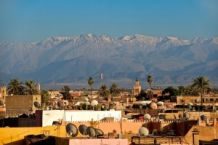Embark on an unforgettable 14-day tour of Morocco, a land where ancient traditions blend seamlessly with modern vibrancy. A comprehensive two-week tour can offer travelers a tapestry of experiences as diverse as Morocco’s landscapes. From the windswept Atlantic coast to the sun-baked Sahara, from imperial cities steeped in history to mountain villages frozen in time, this 14-day Moroccan private adventure is a feast for the senses and a step back in history. Join us as we guide you through the ultimate two-week tour of this North African jewel, exploring its imperial cities, vast deserts, and charming coastal retreats.
The Imperial Cities: A Legacy of Power and Culture
Your Two-week tour of Morocco begins in the famed Imperial Cities, each a former capital that has left an indelible mark on the nation’s history and culture.
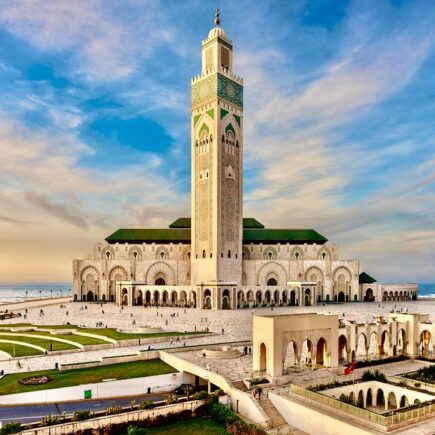
Casablanca: Morocco’s Modern Face
While not an imperial city, Casablanca serves as the gateway to Morocco. This bustling metropolis, immortalized by the eponymous 1942 film, is the country’s economic powerhouse. The star attraction here is the Hassan II Mosque, a masterpiece of modern Islamic architecture. Built partly on reclaimed land over the Atlantic Ocean, its minaret soars 210 meters, making it the world’s second-tallest minaret and a beacon of Morocco’s religious and cultural pride.
Casablanca’s history stretches back to the 7th century BC when it was a Berber settlement. However, it was under French protectorate in the early 20th century that the city boomed, becoming a key port and industrial center.
Rabat: The Capital of Contrasts
The second stop on our 14-day tour is Rabat, Morocco’s current capital. Here, wide palm-lined boulevards and art deco architecture from the French protectorate era contrast with the narrow alleys of the old medina. The city’s skyline is dominated by the Hassan Tower, the minaret of an incomplete 12th-century mosque. Nearby, the ornate Mausoleum of Mohammed V, completed in 1971, houses the tombs of the current king’s grandfather and father.
Rabat’s history as a capital dates back to the 12th century when it was established as a ribat (fortress) against the Spanish by the Almohad ruler Abd al-Mu’min. It became the modern capital in 1912 under the French protectorate.
Meknes: The Moroccan Versailles
Often overlooked by tourists, Meknes offers a more laid-back imperial city experience on our two-week Morocco tour. The legacy of Sultan Moulay Ismail, who made Meknes his capital in the 17th century, is evident in the city’s impressive gates and fortifications. The mammoth granaries of Heri es-Souani, built to feed the sultan’s 12,000 horses, are a testament to Moulay Ismail’s grand ambitions.
Meknes reached its zenith under Moulay Ismail (1672-1727), who aimed to create a capital to rival Versailles. His building projects were so extensive that he was nicknamed the “Warrior King” and the “Moroccan Louis XIV.”
Volubilis: Rome in Africa
A short drive from Meknes lies Volubilis, the best-preserved Roman ruins in Morocco. Walking among the remarkably intact mosaics and columns, it’s easy to imagine life in this far-flung corner of the Roman Empire. The site offers stunning views over the surrounding olive groves and wheat fields, a landscape that has changed little since Roman times.
Volubilis was the westernmost city of the Roman Empire, founded in the 3rd century BC. It was abandoned in the 11th century and excavated by French archaeologists in the early 20th century.
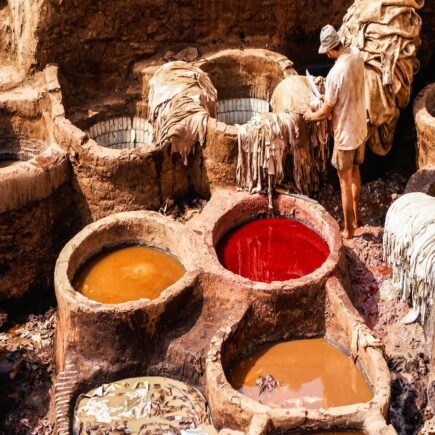
Fes: The Athens of Africa
Our imperial city tour culminates in Fes, Morocco’s cultural and spiritual capital. The medina of Fes el-Bali, founded in the 9th century, is a UNESCO World Heritage site and the world’s largest car-free urban area. Getting lost in its 9,000 narrow derbs (alleys) is a highlight of our two-week Moroccan adventure. Here, you’ll find the famous leather tanneries, where hides are still processed using methods unchanged for centuries.
A visit to Al-Qarawiyyin, founded in 859 AD and considered the world’s oldest continuously operating university, offers a glimpse into Morocco’s long tradition of Islamic scholarship.
Fes was founded in 789 by Idris I, who created the Idrisid dynasty. It reached its golden age in the 13th-14th centuries under the Marinids, when it replaced Marrakech as the capital. The city has been called the “Athens of Africa” and the “Mecca of the West” for its religious and cultural importance.
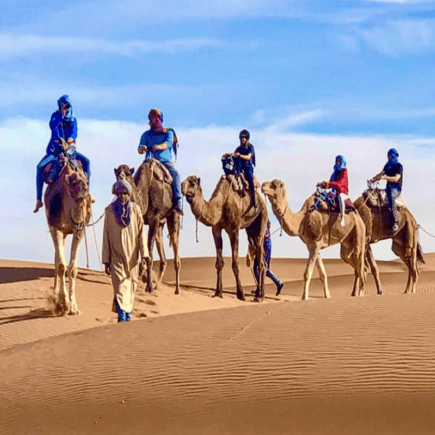
Into the Moroccan Sahara: Erg Chebbi, A Desert Adventure
Leaving the imperial cities behind, venture into the Sahara, Morocco’s vast desert expanse that has shaped the nation’s history and culture. The small town of Merzouga serves as the gateway to Erg Chebbi, a 50 km long and 5 km wide set of sand dunes that rise up to 350 meters. Here, we embark on a camel trek into the desert, experiencing the same mode of transport used by desert traders for centuries. As night falls, we reach our luxury desert camp, where a traditional Berber meal awaits under a canopy of stars.
The Sahara has been home to nomadic Berber tribes for millennia. These tribes developed complex trade routes, linking sub-Saharan Africa with the Mediterranean world. The camel, introduced to North Africa around 200 AD, revolutionized desert travel and trade.
Todra Gorge and Dades Valley: Nature’s Sculpture Gallery
Leaving the sand seas behind, enter a world of dramatic rock formations. The Todra Gorge, with its 300-meter high walls and crystal-clear river, offers a refreshing contrast to the desert heat. Further on, the Dades Valley, known as the “Valley of a Thousand Kasbahs,” presents a stunning landscape of unusual rock formations and ancient fortified villages. These valleys have been inhabited by Berber people for thousands of years. The kasbahs, fortified earthen dwellings, were built by powerful families during the 19th century as both residences and defensive structures.
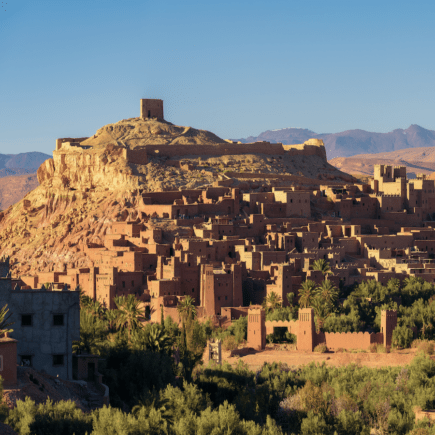
From Ouarzazate to Marrakech: Where Hollywood Meets History
Ait Benhaddou: A Fortress Frozen in Time
Your Two-Week Moroccan journey continues to Ait Benhaddou, a striking example of southern Moroccan architecture. This ancient ksar (fortified village) seems to rise organically from the surrounding landscape. Its well-preserved kasbahs have made it a favorite location for Hollywood, featuring in films like “Gladiator” and “Game of Thrones.” Ait Benhaddou was a key stop on the caravan route between the Sahara and Marrakech. Most of the town’s inhabitants now live in a more modern village on the other side of the river, leaving the ksar as a beautifully preserved relic of a bygone era.
Ouarzazate: Africa’s Hollywood
Known as “Ouallywood,” Ouarzazate is home to Atlas Film Studios, where numerous international films and TV shows have been shot. The stark beauty of the surrounding landscape has made it a stand-in for everything from ancient Rome to Tibet. Ouarzazate was built as a French garrison town in the 1920s. Its film industry began in the 1960s, with the region’s diverse landscapes and reliable sunshine attracting international productions.
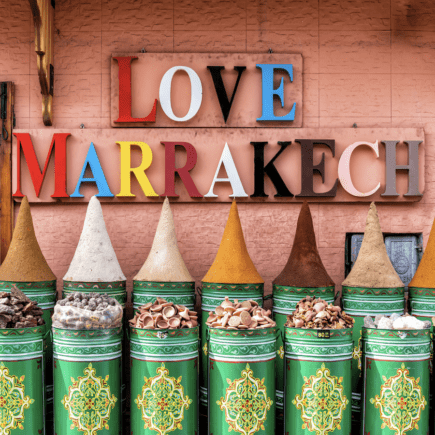
Marrakech: Where a Thousand and One Nights Come to Life
Your final imperial city on this two-week tour, Marrakech, is a sensory overload in the best possible way. The heart of the city is Djemaa el-Fna, a square that transforms from a daytime market to a night-time carnival of food stalls, musicians, and storytellers. In the surrounding souks, you can shop for everything from aromatic spices to handcrafted lanterns. The city’s monuments reflect its imperial past: the Koutoubia Mosque, with its distinctive minaret, has been the model for countless other mosques across the Maghreb. The opulent Bahia Palace showcases the finest Moroccan craftsmanship, while the serene Saadian Tombs offer a glimpse into the city’s golden age.
For a touch of 20th-century glamour, visit the Jardin Majorelle, a stunning blue and yellow garden created by French painter Jacques Majorelle and later owned by Yves Saint Laurent.
Founded in 1062 by the Almoravids, Marrakech became a major Islamic center under the Almohads in the 12th century. The iconic Koutoubia Mosque dates from this period. The city’s name gave rise to the country’s English name, Morocco.
Coastal Retreat: Essaouira’s Breezy Charm
Your 14-day tour of Morocco concludes in Essaouira, a whitewashed coastal town that offers a relaxing contrast to the inland cities. Known as the “Wind City of Africa,” Essaouira has long attracted wind and kite surfers, as well as artists and musicians drawn by its laid-back vibe. The town’s medina, another UNESCO World Heritage site, is a joy to explore with its blue-shuttered houses and sturdy sea ramparts. At the bustling port, you can watch fishermen bring in the day’s catch and enjoy some of the freshest seafood in Morocco. While inhabited since prehistoric times, the present city was built in the 18th century by Sultan Mohammed ben Abdallah, who hired a French architect to design a modern port city. It became an important port, linking Morocco with Europe and the rest of Africa.

A Feast for the Senses: Moroccan Cuisine
No two-week tour of Morocco would be complete without mentioning its world-renowned cuisine. Throughout your 14-day journey, we’ll savor a variety of dishes that reflect Morocco’s diverse cultural influences:
- In Fes, try the city’s famous harira soup and savor pastilla, a sweet and savory pie traditionally made with pigeon.
- In the Sahara, enjoy mechoui, a whole lamb slow-roasted to perfection, with your Berber hosts.
- Marrakech offers tangia, a Marrakechi specialty of lamb slow-cooked with preserved lemon and spices.
- In Essaouira, feast on the freshest grilled sardines and seafood pastilla.
And of course, no meal is complete without Morocco’s ubiquitous mint tea, a symbol of hospitality and friendship.
Practical Considerations for Your Two-Week Morocco Tour
- When to Go: Spring (March to May) and Fall (September to November) offer the most pleasant temperatures for a 14-day tour.
- Getting Around: While public transportation is available, a private two-week tour allows for a more comfortable and comprehensive experience.
- Cultural Sensitivity: Morocco is a Muslim country. Dress modestly, especially when visiting religious sites. Always ask before photographing people.
- Language: Arabic and Berber are the official languages, but French is widely spoken. English is increasingly common in tourist areas.
From the ancient medinas to the vast Sahara, from imperial palaces to humble Berber villages, this two-week tour of Morocco offers a journey through time as much as space. Each city, each landscape tells a story – of empires risen and fallen, of cultures met and melded, of traditions passed down through generations. As you travel through this extraordinary country on your two-week adventure, you’re not just a tourist, but a time traveler, walking in the footsteps of Roman legionnaires, Moorish scholars, Saharan traders, and French colonists.
Morocco’s magic lies in its ability to surprise and delight at every turn of your 14-day journey. It’s a land where ancient traditions live on in everyday life, where the call to prayer mingles with the beeping of mopeds, where centuries-old crafts are practiced alongside cutting-edge art and design. It’s a place that challenges your preconceptions and rewards your curiosity.





